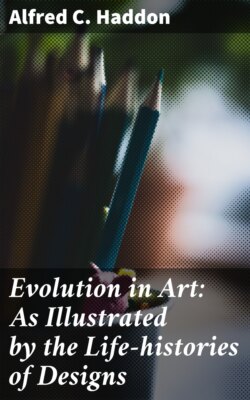Читать книгу Evolution in Art: As Illustrated by the Life-histories of Designs - Alfred C. Haddon - Страница 14
На сайте Литреса книга снята с продажи.
III. Double row of faces disposed vertically.
Оглавление(1.) The faces only looking towards one another.—In the belt represented in Fig. 14 there is a double row of faces which are placed vis-à-vis. The figure illustrates varying degrees of degeneracy in the faces; each space between a pair of faces is occupied by a large red star with a central eye-spot. The representation of a lizard on this belt is noteworthy.
Fig. 14.—British Museum.
(2.) The faces only looking away from one another.—In Fig. 15 it is evident that we have a double series of faces which are placed back to back; the two pairs of eyes are represented by a central eye. The noses and mouths of the different faces are joined together and constitute a fairly regular pattern.
(3.) The faces alternately looking towards and away from one another.—In this series the faces may all be equally developed, or those facing one another may be most prominent, or, on the other hand, those looking away from one another may monopolise the design.
Fig. 15.—Toaripi (Author’s Collection).
Fig. 16.—Berlin Museum.
A simple modification of the subdivision in which the faces are all equal is to be found in Fig. 16. In this case the two eyes of each face have amalgamated, and a short line represents the nose; but their disposition is still typical. The oblique lines uniting the noses are evidently the remains of the mouths of their respective faces; a tooth-pattern may be present or absent. The chevrons merely fill up the vacant angles. The terminal face is represented by a red three-rayed area, containing an eye-spot.
